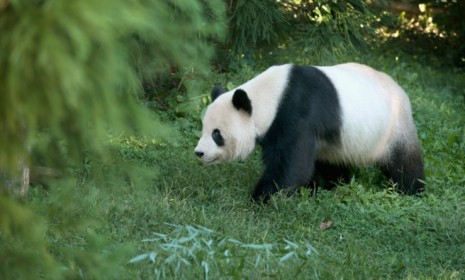The death of the National Zoo's week-old giant panda cub: What went wrong?
Celebration turned to mourning Sunday when the Washington, D.C., zoo's 6-day-old panda cub suddenly died

A week ago, officials at the Smithsonian's National Zoo in Washington, D.C., joyfully announced the birth of a cub delivered by Mei Xiang, the zoo's 14-year-old female giant panda. It was her second successful pregnancy in seven years with her mate, 15-year-old Tian Tian. The celebration was brief, however. On Sunday, the tiny cub, which had yet to receive its own name, died. "The loss, there's no other word for it," says National Zoo Director Dennis Kelly. "It's just devastating." What went wrong? Here, a brief guide to how jubilation turned to grief:
What killed the cub?
Zoo officials don't know yet, and investigators are performing a necropsy. Panda cubs are notoriously delicate, and the first week of life is especially critical. Mother bears must keep their little ones warm and make sure they eat enough. But the bears are so tiny in infancy — about the size of a stick of butter — that their moms, 1,000 times heavier, can easily crush them while trying to nurse, as happened at two zoos in China in 2009 and 2010.
The Week
Escape your echo chamber. Get the facts behind the news, plus analysis from multiple perspectives.

Sign up for The Week's Free Newsletters
From our morning news briefing to a weekly Good News Newsletter, get the best of The Week delivered directly to your inbox.
From our morning news briefing to a weekly Good News Newsletter, get the best of The Week delivered directly to your inbox.
What else can go wrong?
Another newborn panda, the first born in a Japanese zoo in 24 years, died in July at one week of age when its mother's milk entered its airway. Indeed, many giant pandas born in captivity don't live to adulthood. Of the seven born at the National Zoo, only one, Tai Shan, has survived.
Why were D.C. zoo keepers optimistic about this cub?
Mei Xiang had a successful track record — she is Tai Shan's mother. And Mei Xiang has enjoyed better health than Ling Ling, a panda that gave birth to five cubs over her 20 years at the zoo, only to see all five die. Mei Xiang "did a phenomenal job the first time around," said Nicole MacCorkle, one of the panda's keepers. "It's very different than with Ling-Ling. She had chronic uterine infections, so her cubs were born with a compromised immune system. It's comparing apples and oranges."
A free daily email with the biggest news stories of the day – and the best features from TheWeek.com
Why couldn't zoo keepers save the cub?
Because a cub is so fragile, zoo keepers can't safely try to handle it for about three weeks, when Mei Xiang would have started feeling comfortable enough to leave it alone for about 20 minutes at a time. Since she had been such a good mother the first time around, the zoo keepers felt confident that the baby would have the best possible chance of survival if they let its mom "call the shots." Mei Xiang handled the new cub with the same attention and care as she had the first one, cradling it and laying it down gently, picking it up again if it squawked. "She is the poster child for a perfect panda mom," chief zoo vet Suzan Murray wrote shortly after the birth.
Was there any indication something was wrong?
Not until Sunday morning, when the mother panda honked in distress. A veterinarian examined the cub, and found it wasn't breathing, and had no heartbeat. Zoo officials tried CPR and other life-saving measures, but nothing worked. At 10:28 a.m., about an hour and a half after the cub had made its last audible grunt, veterinarians pronounced the cub dead. "We're all very anxious to know what happened," says Murray, "but we won't know that for a little while yet." In the meantime, the zoo and panda lovers everywhere are dealing with what they describe as a crushing loss.
Why is this so devastating?
The birth of a panda cub is always great cause for celebration, as there are only about 1,900 of the pudgy, black-and-white bears left in the world. "These bears are so critically endangered that every panda cub is important," says Murray. The cub was conceived through artificial insemination, and there was only a 20 percent chance — perhaps as low as 10 percent — that the process would lead to a pregnancy. The panda exhibit was closed as a precaution, so mother and cub would not be disturbed as zoo officials kept vigil at all times via panda cam during the "nerve-wracking" first week. As zoo director Kelly puts it: "It's hard to describe how much passion and energy and care has gone into this."
Sources: CNN (2) The Stir, USA Today, U.S. News & World Report, Washington Post
-
 Political cartoons for January 3
Political cartoons for January 3Cartoons Saturday's political cartoons include citizen journalists, self-reflective AI, and Donald Trump's transparency
-
 Into the Woods: a ‘hypnotic’ production
Into the Woods: a ‘hypnotic’ productionThe Week Recommends Jordan Fein’s revival of the much-loved Stephen Sondheim musical is ‘sharp, propulsive and often very funny’
-
 ‘Let 2026 be a year of reckoning’
‘Let 2026 be a year of reckoning’Instant Opinion Opinion, comment and editorials of the day